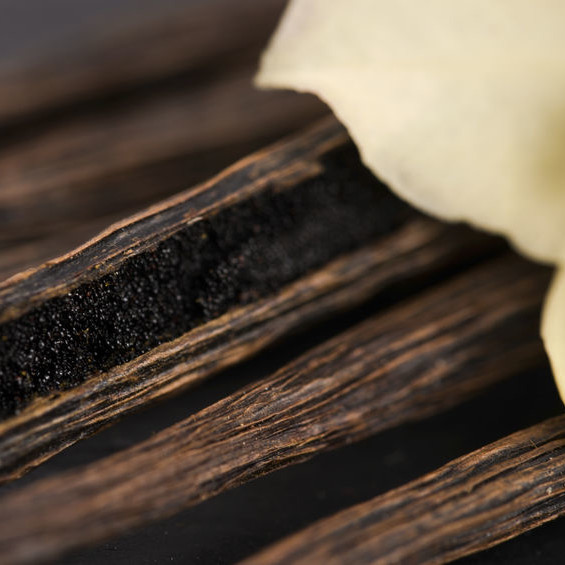Vanilla
What is Vanilla?
Vanilla is an aromatic flavoring agent obtained from the vanilla bean with vanillin being the principal flavor component. It is the most used flavor in foods and baked goods due to its sweetness and ability to enhance other flavors.1,2
Commercially, it is available in various forms:
- Pure extract
- Flavoring
- WON4352F (with other natural flavors)
- Oleoresin
- Powder
- Artificial vanillin
- Sugar
Origin
Vanilla (Vanilla planifolia) is thought to have originated in Central and Northern America, more precisely Mexico. In the 16th century, it was introduced to Europe by Spanish conquerors. In the US, vanilla has been sold for over a 100 years in supermarkets and retail stores.1,2 Various types of vanilla beans such as Bourbon, Tahitian and Indonesian are known with various flavor profiles.
A relatively new FDA-approved natural source of vanilla is Castoreum, a molasses-like compound obtained from beaver’s castor sacs located between its pelvis and tail base. Due to the tedious extraction process, only very limited amounts are available commercially.3
Function
It is used in baked goods for:1,2
- Flavor and aroma: provide a characteristic sweet flavor
- Enhancer of other flavors.
Types / Variations
- Pure extract: is the hydro-alcoholic product obtained from crushed vanilla bean with ethyl alcohol in proportion of 1:10 by weight.2
- Flavoring: similar to vanilla extract but with a lower amount of ethyl alcohol and higher flavor concentration than the extract.2
- WON4352F (with other natural flavors): it is a vanilla flavoring made with natural flavor, it may or not contain vanilla beans.2
- Oleoresin: it is a semi-solid concentrate obtained from the removal of ethyl alcohol of vanilla extract.2
- Vanilla powder: it is dried vanilla powder mixed with sugar, starch or gum acacia. It can also be made with a mixture of vanilla powder and vanilla oleoresin.2
- Artificial vanillin: Commonly made from guaiacol, eugenol or lignin. Around 4% of “vanilla” used in food products is made from lignin.4
- Vanilla sugar: made from ground vanilla beans and sugar, or by mixing vanilla extract with sugar.2
Nutrition
Vanillin, vanilla’s main volatile compound, can produce serious allergic reactions when consumed in excess (above the recommended daily intake of 10 mg/kg.4
Commercial production
It is commercially produced through the following processes:1,2,4
Pure extract
- Extraction: finely cut vanilla beans are soaked in a 35% ethyl alcohol
- Distilling of the solvent
- Bottling of the vanilla extract
Artificial vanilla
- First reaction: eugenol is mixed with a dilute solution of sodium hydroxide under pressure at about 160°C (320°F)
- Second reaction: conversion of isoeugenol to sodium vanillate
- Precipitation: vanillin is precipitated and filtered from the solution
Application
Vanilla can be used as a whole bean or in other forms. It is typically added in the final steps of mixing in cakes, cookies and other sweet goods.1,2,3 Vanilla flavor release is most efficient in lipid media.
Considerations when using vanilla in baked goods:
- Beans: Keep in mind that different varieties may produce different flavor profiles which are often different than an equivalent amount of vanilla extract. The flavor is most prominent when the split bean is infused in hot liquid such as milk.
- Extract: provides consistent flavor between uses and is most common in baking applications
Usage level depends on the following factors:
- High levels of vanilla are required for lower fat and high protein products.
- When working with high temperature, higher concentration of vanilla may be added to compensate for evaporation losses, using encapsulated vanilla can rectify this problem.
Regulations
Vanilla is considered safe by the FDA, when produced following good manufacturing practices. It establishes the composition of vanilla extract at 35% content of ethyl alcohol.5
In the EU, vanilla is regulated by the EU Commission No 1334/2008 like other flavoring agents.6
References
- Havkin-Frenkel, Daphna, and Faith C. Belanger, eds. Handbook of vanilla science and technology. Chichester: Wiley-Blackwell, 2011.
- Anandan, A. Vanilla: The Green Gold. Sura Books, 2004.
- Bloudoff-Indelicato, M. 2013. Beaver butts emit goo used for vanilla flavoring. https://api.nationalgeographic.com/distribution/public/amp/news/2013/10/beaver-butt-goo-vanilla-flavoring.
- Grumezescu, Alexandru Mihai, and Alina Maria Holban, eds. Natural and Artificial Flavoring Agents and Food Dyes. Vol. 7. Academic Press, 2017.
- Food and Drug Administration (FDA). US Department of Health and Human Services. CFR Code of Federal Regulations Title 21, Part 169 Food Dressing and Flavorings, https://www.accessdata.fda.gov/scripts/cdrh/cfdocs/cfcfr/cfrsearch.cfm?fr=169.175 , Accessed 13 November 2020.
- European Commission (Ec). Regulation (Ec) No 1334/2008 Of The European Parliament And Of The Council Of 16 December 2008 On Flavourings And Certain Food Ingredients With Flavouring Properties For Use In And On Foods And Amending Council Regulation (Eec) No 1601/91, Regulations (Ec) No 2232/96 And (Ec) No 110/2008 And Directive 2000/13/Ec. Official Journal Of European Communities, 16 December 2008.


